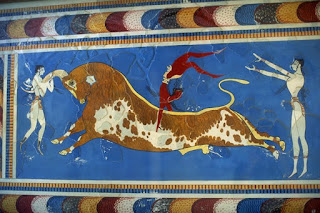The author of these pages is currently resident in the old city of George Town on the Prince of Wales Island, the only city in Malaysia that boasts a Chinese majority. A feature of the old city is the beautiful temples and clan houses, some of them very extensive and sumptuous, some very old. They are among the best Taoist and Confucian temples outside of China proper. Chinese from both Formosa and the mainland travel to George Town to visit them. It is a major temple city and a major centre of traditional Chinese religion.
An immediately obvious feature of such temples, and the attending buildings, and the Chinese domestic terrace houses too, is the proliferation of octagonal forms – tile designs, floor patterns, sacred insignia, altar iconography, and so on. The Chinese “lucky colour” is vermillion. The “lucky number”, as the Chinese will tell you, is eight. Sets of eight, preferably arranged in octagonal forms, are considered auspicious. It is by far the most common geometrical motif in traditional Chinese decoration.
Below are a few examples of octagonal forms to be seen around George Town. Some of the roads feature large octagonal designs and octagonal tile designs are everywhere to be seen. The geometrical tiles themselves were originally imported from Sheffield by the British, but the Chinese were so taken by them – such is their love of the octagonal pattern - that they adopted them as a standard feature of their homes, temples and pathways. The present author has noted the tile patterns of George Town - one of the most striking and beautiful features of the old city - in a previous post here.
This is the form appropriated from the Byzantine Christians by the Mahometans when they built the Dome of the Rock in Jerusalem – perhaps the most impressive octagonal building in the world. It was possibly from this inspiration that Emperor Frederick – who had seen the Dome of the Rock during the Crusades - built his mysterious octagonal folly, the Castel de Monte, in southern Italy. All the same, these architectural examples are exceptions. The octagon is not as conspicuous as a symbol in the occidental world as it is in the orient. It occurs naturally in Mahometan geometrical patterns, but there it is not imbued with the same symbolic value – marked as “auspiciousness” – that we find among the Chinese.

Basically, the symbolism of the octagon is this: it is an intermediate form between the circle (of heaven) and the square (of earth). Its primary meaning therefore is: regeneration. It signals: the square that returns to the circle. That is, it consists of two superimposed squares which are in the process of returning into a circular form. Thus the association with baptism: the rite of regeneration. In the Chinese (which is to say Taoist) context, though – and this is quite apart from its correspondences with the eight trigrams of the I Ching and other symbolic parallels such as the eight directions – the signification of regeneration is overtly alchemical.
As with the colour red, the meaning behind the “luck” the Chinese associate with the symbol is to be understood via the strongly alchemical nature of the Chinese order. Alchemy concerns exactly this: regeneration. The regeneration of matter into spirit (if we are to describe it dualistically). The regeneration of base metals into gold. In the octagon, the square (matter, earth) is regenerating into the circle (spirit, heaven). It is for this reason that it finds such a prominent place in the Chinese tradition – it is the pre-eminent (stable) expression of the doctrine of alchemical regeneration, which is the core theme of Chinese spirituality.

The Castel del Monte
Basically, the symbolism of the octagon is this: it is an intermediate form between the circle (of heaven) and the square (of earth). Its primary meaning therefore is: regeneration. It signals: the square that returns to the circle. That is, it consists of two superimposed squares which are in the process of returning into a circular form. Thus the association with baptism: the rite of regeneration. In the Chinese (which is to say Taoist) context, though – and this is quite apart from its correspondences with the eight trigrams of the I Ching and other symbolic parallels such as the eight directions – the signification of regeneration is overtly alchemical.
As with the colour red, the meaning behind the “luck” the Chinese associate with the symbol is to be understood via the strongly alchemical nature of the Chinese order. Alchemy concerns exactly this: regeneration. The regeneration of matter into spirit (if we are to describe it dualistically). The regeneration of base metals into gold. In the octagon, the square (matter, earth) is regenerating into the circle (spirit, heaven). It is for this reason that it finds such a prominent place in the Chinese tradition – it is the pre-eminent (stable) expression of the doctrine of alchemical regeneration, which is the core theme of Chinese spirituality.
Yours,
Harper McAlpine Black
Harper McAlpine Black















































































